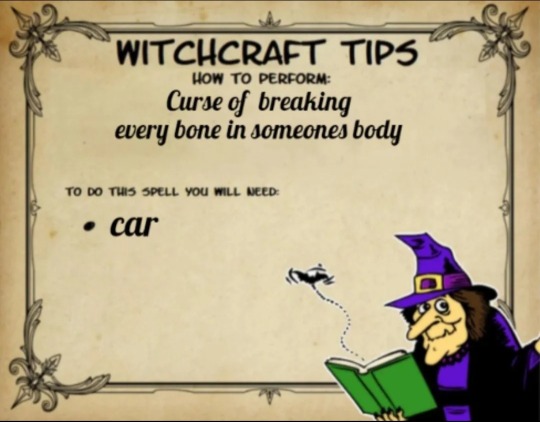⋆˖⁺‧₊☽◯☾₊‧⁺˖⋆ kismet skeptical witchcraft⋆˖⁺‧₊☽◯☾₊‧⁺˖⋆
Don't wanna be here? Send us removal request.
Text
Magic For The Disabled
A few things that I do when I’m at my lowest. Made specifically for disabled people, but anyone can do these! See this post for low energy witchcraft ideas not directly related to disabilities.
Enchant your blanket for a good night’s rest
Enchant your coffee/juice/water/NyQuil/whatever you’re drinking to aid in recovery
Enchant food to aid in recovery
Place sigils around to aid in recovery, memory, etc.
Keep relaxing herbs/stones/etc. around
Cast a sleep aid spell (I have a bag with lavender and amethyst hanging on a bedpost)
Cast a recovery spell (I have another bag with a variety of protection and rest herbs and crystals)
Enchant fidgets or objects used to stim to calm you and to never break
Use energy magic instead of physical spells.
Use art/writing/etc. magic! Draw sigils, deities, write spells, recipes, shopping lists, etc.
Stir and infuse good energy/banishing into teas or coffees.
Keep some supplies nearby (i.e. tea lights, a lighter, grimoire, oils, etc.).
Use showers, washing of face/hands, etc. for cleansing.
Brush out the bad energy when brushing your hair.
Ward health aids or mobility aids against breaking and bless them to work quickly and well.
Use apps or websites for sigils, spells, etc. (VirtualCandleSpell for digital candle spells, Craiyon for sigils).
Keep room sprays near you and bless them to serve a certain purpose.
Make emoji/song spells! Use corresponding emojis and charge them with intent. Use corresponding songs, put them on a playlist, charge them, and listen to it whenever you want to cast it.
Use makeup/skincare as glamours.
Use sunscreen as protection!
Use wax warmers and melts instead of candles.
Use oils in diffusers instead of candles or incense.
Enchant anything you use daily.
2K notes
·
View notes
Text
The knowledge of some common plants
Since many people don't know most of the plants around them, this is information on some plants that are commonly seen in many places throughout the world
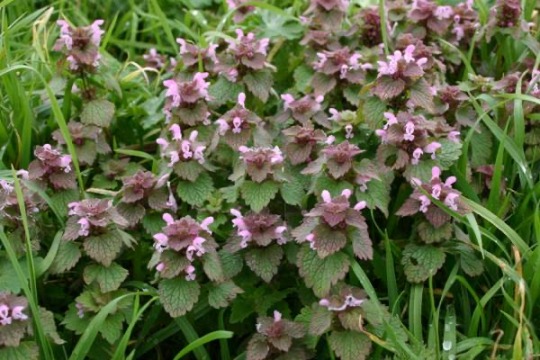
This is Lamium purpureum, also called Purple Deadnettle.
It's called deadnettle because it looks like a nettle but it doesn't sting you
This plant is a winter annual—it grows its leaves in the fall, lasts through the winter, and blooms and dies in the spring
Its pollen is reddish orange. If you see bees with their heads stained reddish orange, it is likely because they have visited Purple Deadnettle
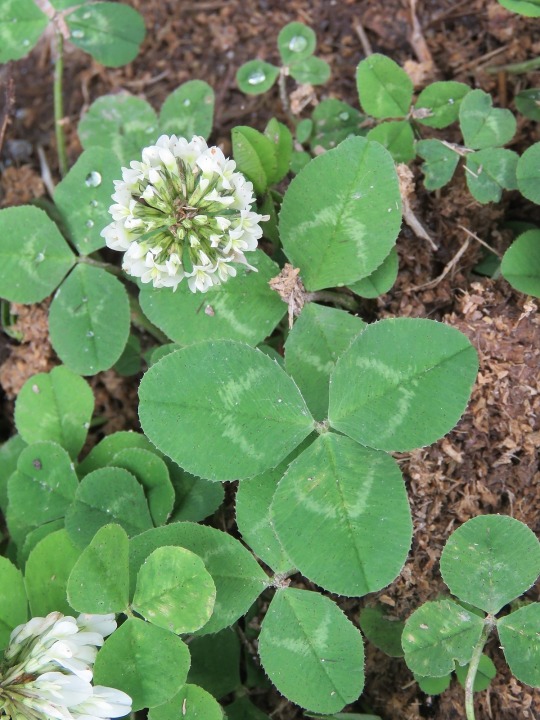
This is Trifolium repens, white clover
It is a legume (belongs to the bean family) and fixes nitrogen using symbiosis with bacteria that live in little nodules on its roots, fertilizing the soil
It is a good companion plant for the other members of a lawn or garden since it is tough, adaptable, and improves soil quality. According to my professor it used to be in lawn mixes, until chemical companies wanted to sell a new herbicide that would kill broadleaved plants and spare grass, and it was slandered as a weed :(
It is native only to Europe and Central Asia, but in the lawns they are doing more good than harm most places
Honeybees love to visit clover
Four-leaf clovers are said to be lucky
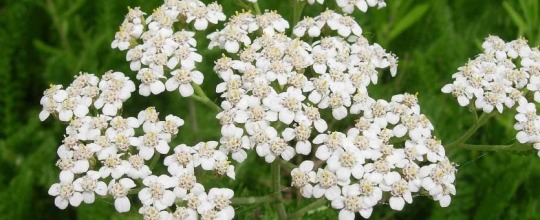
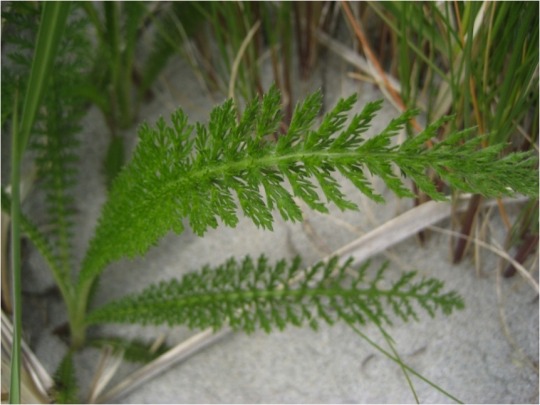
This is Achillea millefolium, Common Yarrow
It has had a relationship with humans since Neanderthals were around, at least 60,000 years, since Neanderthals have been found buried with Yarrow
Its leaves have been used to stop bleeding throughout history, and its scientific name comes from how Achilles was said to have used Yarrow to stop the blood from the wounds of his soldiers. A leaf rolled into a ball has been used to stop nosebleeds
It is a native species all throughout Eurasia and North America

This is Cichorium intybus, known as Chicory
The leaves look a lot like dandelion leaves, until in mid-spring when it begins growing a woody green stem straight up into the air
Like many other weeds, it has a symbiotic relationship with humans, existing in a mix of domesticated or partially domesticated and wild populations
It is native to Eurasia, but widespread in North America on roadsides and disturbed places, where it descended from cultivated plants
Its root contains large amounts of inulin, which is used as a sweetener and fiber supplement (if you look at the ingredients on the granola bars that have extra fiber, they usually are partly made of chicory root) and has also been used as a coffee substitute
A large variety of bees like to feed upon it

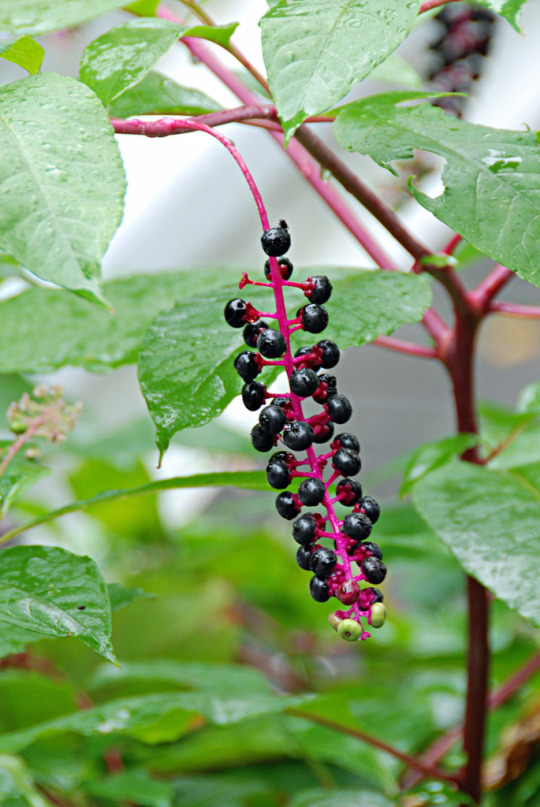
This is Phytolacca americana, known as Pokeweed
It is easily identified by its huge leaves and its waxy, bright magenta stem
It can grow more than nine feet tall from a sprout in a single summer!
If you squish the berries, the juice inside is a shocking magenta that is so bright it almost burns your eyes. For this reason many Native American people used it for pink and purple dye.
It is a heavy metal hyperaccumulator, particularly good for removing cadmium from the soil
All parts of the plant are poisonous and will make you very sick if you eat them, however if the leaves are picked when very young and boiled 3 times, changing out the water each time, they can be eaten, and this is a traditional food in the rural American Southeast, but I don't want to chance it
British people have introduced it as a pretty, exotic ornamental plant. I think that is very funny considering that here it is a weed associated with places where poor people live, but maybe they're right and I need to look closer to see the beauty.
If you see magenta stains in bird poop it is because they ate pokeweed berries- birds can safely eat the berries whereas humans cannot

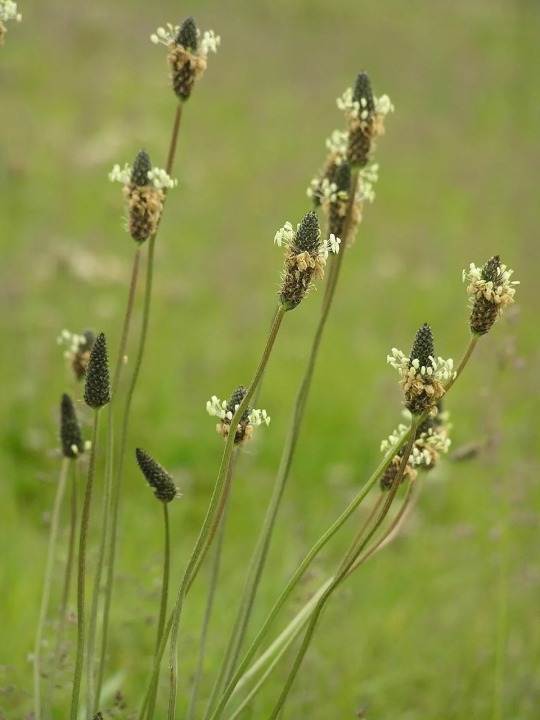
This is Plantago lanceolata, Ribwort Plantain
It grows in heavily disturbed soils, in fact it is considered an indicator of agricultural activity. It is successful in the poorest, heaviest and most compacted soil.
The leaves, seeds, and flower heads are said to be edible but the leaves are really stringy unless they are very young. Of course, it is important to be careful when eating wild plants, and make sure you have identified the plant correctly and the soil is not contaminated
I have also heard the strings in the leaves can be extracted and used for textile purposes
and that's some common plants you might often see throughout the world
5K notes
·
View notes
Text
Kitchen Staples and Their Properties
If you're any kind of kitchen user, there are a few things that are usually present. Things like bread, cheese, beans, and vinegar are all things that many kitchens keep in stock. So, here is a list of some staples you may have in your kitchen, and what they mean.
Bread: health, abundance, the hearth, kindship
Beans: wisdom in choices, luck, money, divination, prosperity
Butter: peace, friendships/relationships, spirituality
Cheese: goal completion, happiness, moon magic, health
Eggs: feminine/goddess magic, fertility, mysticism
Honey: joy, love, sex, wisdom, lust, purification, health
Milk (Cow's): feminine parenthood/guidance, love, sustenance, spirituality,
Rice: fertility, protection, luck, money, growth
Salt: purification, protection, grounding, cleansing
Sugar: banishing negativity, love, affection, invoking kindness/sweetness
White Vinegar: cleansing, purification, protection
Adding some things together melds their properties! Cooking in butter for your friends can strengthen your relationships with them, and baking bread can bring abundance into your home.
As always, do your research, practice safely, and blessed be!
Support your local witch on Ko-Fi!
4K notes
·
View notes
Text
January Week 1
Welcome welcome to the 2024 Grimoire Challenge! Time to really get started everyone! This week will have a lot of stuff all jammed in. So buckle up, grab your grimoire and your supplies, and let’s get to work!
Monday
Name your book - this may seem silly and you definitely don’t need to name your book. Not properly at least. Other than “my grimoire” or “book of shadows” or what have you, which is totally fine. But some of us might feel the need to give it a proper title. “The Basil Grimoire” or “Hazel’s Handwritten Workings” something, anything, that ties the book to you and your craft. Make a title page! If you feel so inclined. If not, that’s fine too.
Definitions (New Page) - ritual and spell. Let’s define a few things. Make a page specifically for definitions, that we’ll add to through the challenge. Let’s start with a couple simple definitions. Define spell. And define ritual. Within the confines of magic, witchcraft and your practice. What is a spell? What is a ritual? What are the differences?
Study (herb) - Pick another herb from that list we made, and dig into the details. Make a page for it on its own, or add its info to another page! Whatever works for your craft. The questions to ask for these study prompts are going to continue to remain the same. Where did it come from, where does it grow, how does it grow, what are its mundane and practical uses. What are the myths and legends and stories surrounding the herb? What are its magical properties and why/ how do you think the other information you've learned about it have influenced its magical associations?
Tuesday
Outline/ index (New Page!) - it helped me a great deal to have an index or outline to my grimoire. I started this as a file on my computer as my grimoire grew and changed I could more easily manage it and rearrange it as I saw fit. Then eventually I could make it into a handwritten copy.
Study (gem) - Like our herb prompt, the gem prompts are going to always use the same outline and questions. Where does the gem come from? What is it used for in a practical and mundane sense? What are its physical properties? What are any myths, legends or stories? Where and how does it form? How does all of that relate to its magical correspondences and what does the herb mean to and for you in your craft?
Spellwriting 101 (New Page!) - make a new page dedicated to spellwriting. This is going to be one of those prompts that is focused on you and your craft. How do you write spells? How do you set them up? What components do you use? What is the format? How is it done? What does it require? From materials to timing and circumstances? Write it all out in your lab notebook. Make it a work in progress. Not all spells are going to work out the same or function the same as you perform them, but having a general layout and method helps to focus your practice.
Wednesday
Common tools - What are the common tools in your craft? That is, you don't need to have a list of every single tool ever used in witchcraft, just the tools that you use in yours. Both regularly and less regularly. What are they used for specifically? What purposes do they serve in the magical and practical sense? Are they ceremonial and symbolic or do they serve an actual physical purpose? (i.e. a wand used to direct energy serves many purposes, while an incense burner could literally just be that, an incense burner)
Year outline/ calendar - not everyone celebrates the same days, holidays or even the same holidays the same way. What are the special occasions and days in your calendar? Mark them and when the proper season/ holiday comes around, we can make pages dedicated to those days. This week this will simply be a list of these days, while later we will actually make pages for them individually. Think of it like the Wheel of the Year, Yule to Midsummer and so on. What days are important to you and your practice? Are they actual holidays? Or simply days of power like the full moon? Or is it simply days that are significant for other reasons, like the anniversary of the day you began practicing witchcraft?
Practical - tool usage - practice using your tools. For example if you use a wand. Practice using it to direct energies or whatever it is you utilize it for.
Thursday
Altar design/ work space (New Page!) - make a page dedicated to your altar and its setup. Why are things where they are? The reasoning can be simple as “that’s where it fits” or you can give it a more meaningful reason. Candles in front of or behind something to represent some purpose. Do you have items that represent the elements? Deities? Different sources of power or directionality? Different colors for different meanings? Why is your altar the way it is?
Practical - cleansing space - practice cleansing your space and tools. This is of course a physical and 'energetic' cleansing. Tidy it up, redecorate your space, clean the tools if they have dust or ash or anything on them. Sometimes it is good to have a clean start.
Friday
Personal practices - this is just a thought provoking prompt tied in with the Journal prompt below. What are some of your personal practices that you've brought into your witchcraft? Anything from little habits from your every day life to things brought from religion or family traditions. No matter how hard we try, we carry within us echoes of things not related to our practices into it. And that is totally okay. Recognizing them, acknowledging them, and truly incorporating them can be a huge step toward understanding ourselves, our beliefs and our practices all around.
Journal/ introspective/ meditations - Think about the above and write any of it down that you come to terms with. Self understanding is important in and outside of witchcraft.
Thank you all and I hope this week's prompts aren't too overwhelming! Stay tuned next week for the next set of prompts!
-Mod Hazel
341 notes
·
View notes
Text

My original spread, the Midnight spread is the seasonal reading I'm offering this month!
Interpretation-only readings are $10. Live video readings or hand-drawn illustrated readings are $18.
Send me an ask if you're interested in a reading! Or if you use this reading yourself, tell me about your results!
8 notes
·
View notes
Text
It's always funny and embarrassing when an old discussion post of mine resurfaces.
At this point I define magic very loosely, and consider discussion of what types of magic actually work to be entirely foolish.
None of us can prove that shit. In the end there's just styles of magic you vibe with, and styles that, for whatever reason, you do not. Alleged success rates have little to do with whether or not it's magic.
748 notes
·
View notes
Text
some tarot tips i've collected over the years
- when shuffling, pay attention to the cards that fall out of the deck. sometimes they have a special message for you.
- questions aren't always necessary when reading. letting the cards tell you what they need to helps to develop your intuition, and the relationship between you and your deck (or the spirit you are working with, depending on how you divine information).
- when reading with multiple cards (i.e. as a spread), try and string the cards together rather than interpreting them by their individual meanings:
recurring suits, themes, symbols, and numbers
proportions of suits and uprights vs. reversals
position of the cards (e.g. if people are present in the cards, where are they looking?)
colours of the cards (e.g. do any of the cards stand out more than the rest?)
- although each card has a core meaning, different decks with different art could emanate different "flavours" of the core meaning.
- draw a clarifying card if something confuses you, but try not to draw any more than two cards per reading.
4K notes
·
View notes
Text
wife: you should take care of yourself because you will feel better :)
me: whatever sounds fake
my cards: fucking take care of yourself dumbass
1 note
·
View note
Text
How to Write Your Own Spells
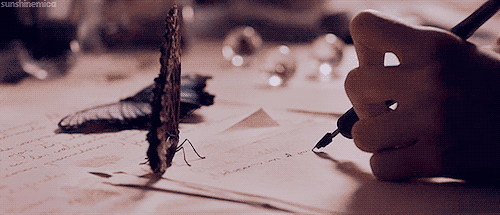
There are lots of ways to create spells, from planning everything to the minutest detail ahead of time to absolutely flying by the seat of your pants in the moment. If you'd like to write your own spells, either for use in your craft or as a creative exercise, here are some suggested steps that I use in my own practice:
1) Determine the intent or goal of your spell. Decide, first and foremost, what you want the spell to do. Refine your goal if necessary and try not to be too nebulous. Your intent tells the spell what it's meant to do. A more focused goal may increase the chances of success.
2) Determine how you want the spell to manifest. Decide how the spell should work and what the result should look like. This is a good time to build in a sign of success, especially for spells that may not work in an obvious or visible way.
3) Determine what or whom the spell will affect. If the spell is to have a target, be it a person or a place or an animal or an object, decide what that should be and how they or it will be represented in the casting.
4) Determine how long the spell is meant to work. If your spell is timebound or has a deadline, decide what that will be. If the spell is meant to work long-term, you may want to check in and refresh it from time to time. (Not every spell will be timebound. Many spells will simply expire when they have fulfilled their purpose or if they are blocked or circumstances are not favorable.)
5) Determine the timing of the spell, if applicable. Not everyone uses celestial or astrological timing for their spells, but if you do, look into the prevailing conditions and decide on an advantageous time for your casting. (Please note that magical timing can only enhance your spell and casting something on the "wrong" day will not necessarily cause it to fail.)
6) Determine what methods and materials you want to use to cast the spell. Decide how you're going to go about performing the casting, whether you're doing a ritual or making a charm or just using energy. If you're going to need a ritual space or physical components, plan that out and make sure it fits with what you want to do.
7) Determine the words, if any, which will empower the spell. If you want to include a prayer or a petition or a song or an incantation with your spell, decide what that should be. This is not strictly necessary and the words need not be spoken aloud. (Rhyming incantations are not required, but if you prefer them that way, you can certainly do so.)
8) Prepare the materials for casting the spell. Get all your necessaries together ahead of time. Make sure you have everything you need, that tools and components are in good and useable condition, prepare your workspace, and make sure everything is within easy reach so you don't have to stop and search for things in the middle of your casting. (And for goodness sake, if you're working with open flame, observe fire safety and tie your hair and sleeves back.)
9) Finalize details and perform the casting. When you're ready to begin, try to eliminate as many possibilities for distraction or interruption as possible. Go over your spell and components one more time, then proceed with casting the spell.
10) Record the particulars for future reference and to determine how well the spell worked. Make a record of the spell, including your goal, how it should manifest, the words and components used, the date of the casting, the casting method and procedure, and how the casting went. If there are any additional details or observations that seem important, include those as well. This will serve as a useful learning tool in the future and will allow you to check your work if the results make themselves known.
It's useful to write spells from time to time if the inspiration strikes you, in order to better understand how they fit together and how they work. Plus it's a fun and creative journaling exercise and recording the spells you cast a great way to measure your progress later on.
For additional tips on writing your own spells and helpful tricks for using timing and available materials to your advantage, check out my podcast, Hex Positive, Eps. 006-007, "Come In For A Spell, pt 1 & 2."
(And if you’re enjoying my content, please feel free to drop a little something in the tip jar or check out my published works on Amazon or in the Willow Wings Witch Shop. 😊)
Happy Witching! 🔮✨
5K notes
·
View notes
Text
anyway normalize women not wanting children as a happy ending
66K notes
·
View notes
Text
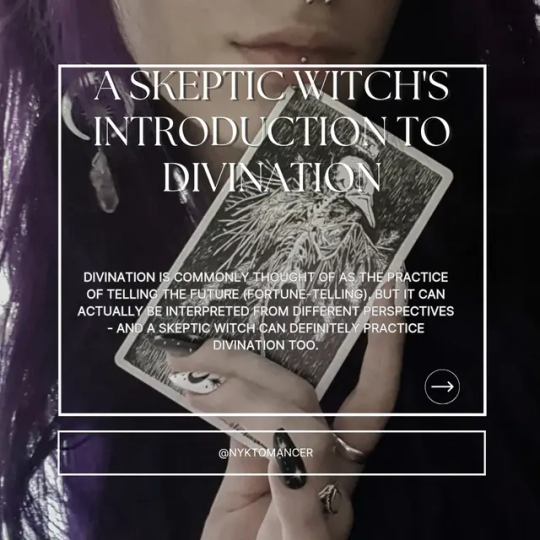


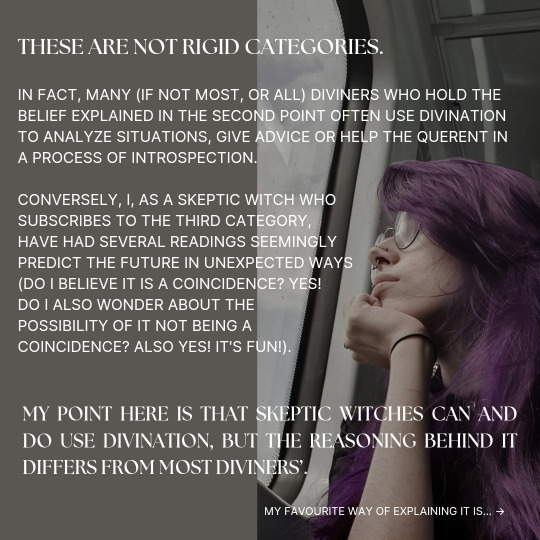

An adaptation of an old post of mine
15 notes
·
View notes
Text



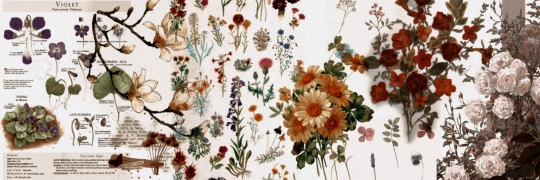
Collage Headers aesthetic
Saved? Like or reblog
Salvou? Curte ou compartilhe
Credit's twitter @DaraInYeop
421 notes
·
View notes
Text
Nontraditional Baneful Work (1)
For the hardcore crystal witch:
Specific harm
On a very sunny day, write on paper: "[Name Of Enemy] will [experience a great misfortune] before [date]" or similar, or use a sigil. Take a sphere of quartz, hold above the paper, and allow the sun to stream through it until the victim's name is scorched from the paper.
Harm in love
Write their name on a slip of paper. On another, write "your/their heart will not find love", similar, or use a sigil. Wrap in cloth or tinfoil with a piece of rose quartz. Unwrap to release.
(Even if you do not cleanse your crystals, I would recommend doing so after using them as described above)
For the elemental witch:
General harm
Create a vial of strong sun water, then "corrupt" with a pinch of pepper or a splash of red dye. On paper, write the name of your victim, and cast them into the vial. Shake vigorously to expedite.
Productivity-related harm
Cast a small item taken from your victim into a vial of ocean water. They now feel as if they are drowning in their responsibilities. Pour out to release.
There are always alternatives to the risk of pickpocketing items on and off of people, but this is a method I have always had success with.
For the nature witch:
Long-term harm
Healthy acorns sink in water, while rotten ones will float (most of the time). Take a floating acorn and and whisper to it its purpose. Sneak it into your victim's belongings and let it take root.
Bad luck
Paint the name of your victim in water on a maple leaf. Place the maple leaf under the candlestick of a black candle and let burn for as long as you like. Negative energy, including that of any standing hexes against you, will be captured and sent on to your victim, even if they are its originator.
(All are based on my own research, practice, experience, and theory. I encourage you to modify these for your own use if I have inspired you.)
1K notes
·
View notes





















